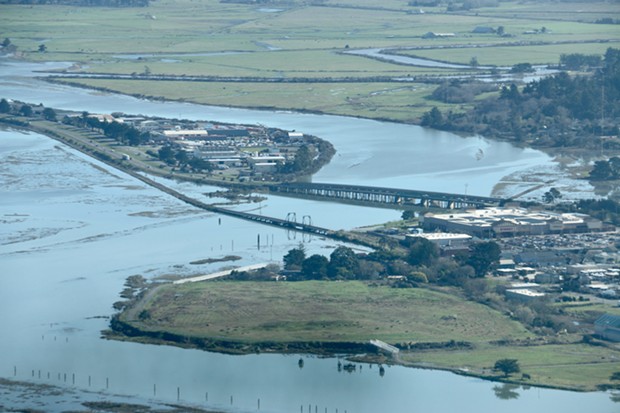News Blog
Study: Humboldt May Need $2.5 Billion by 2040 to Combat Sea-Level Rise

- Jennifer Savage
- Eureka Slough during a recent king tide gives a glimpse of what sea-level rise will look like around Humboldt Bay.
The United States will have to spend more than $400 billion by 2040 to protect coastal communities against sea-level rise, according to a study released this week.
The study, from the Center for Climate Integrity in partnership with the engineering for Resilient Analytics, found the problem would be particularly acute in Humboldt County, which would have to spend $2.5 billion (the second most of any California county) to build 142 miles of seawall (the third most of any California county). That $2.5 billion price tag, the study points out, equates to more than $18,000 per county resident, or roughly six times the county’s annual general fund.
The study points out that without a tremendous amount of aid from the state and federal governments, Humboldt County would be left with the difficult choice of imposing massive reductions to virtually all local services or simply abandoning coastal property and communities to be taken over by the encroaching sea. The second option would result in massive property losses and the flooding of critical infrastructure.
The study found more than 132 coastal counties that would face costs in excess of $1 billion and 14 states that would have to build more than $10 billion worth of sea walls. The hardest hit would be Florida, the study found, which would face nearly $76 billion in seawall construction costs.
And things could potentially be much worse than that, as the study relies on moderate sea-level rise projections and expected annual storm surges, its authors note.
According to a United Press International article, “recent surveys of melting patterns in Antarctica and Greenland suggest Earth’s biggest ice sheets are increasingly unstable, with melt rates accelerating as a result of warmer air and ocean temperatures. Climate scientists agree that the burning of fossil fuels and increase in atmospheric greenhouse gases is to blame for rising global temperatures and sea level rise.”
The Center for Climate Integrity is an initiative of the Institute for Government and Sustainable Development, which bills itself as working “to promote just and sustainable societies and to protect the environment by advancing the understanding, development and implementation of effective and accountable systems of governance for sustainable development. It has stoked some controversy in conservative circles for signing a letter in support of the Green New Deal after accepting more than $6 million in federal Environmental Protection Agency grants over the last decade.
The Center for Climate Integrity posits there is an alternative to seeing state, local and federal governments spending enormous amounts of money to protect coastal communities. Instead, they could institute policies that impose taxes on oil and gas companies that would pay — or at least subsidize — the costs.
“The companies that made and promoted the products that they knew would irrevocably and radically alter the global climate, and then denied it, must pay their fair share to help communities adapt to it,” said Richard Wiles, executive director of the Center for Climate Integrity, in a press release. “Failing to hold polluters to this basic responsibility would be to knowingly bankrupt hundreds of communities, standing idly by as they are slowly and inexorably swallowed up by the sea.”
Comments
Showing 1-1 of 1